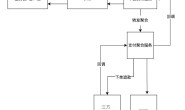前言:
搭go学习web架子的时候看需要验证码看了网上一种实现。
正文:
其实就是绘制点, 网上的demo都有一个字符对应的过程生成256标准的字符对应表喵??搞了半天也不知道为什么这么做,我还以为要增加随机性(防止机器人模拟随机??)网上问了很多人,也看了所谓的这段代码的注释详解。最后我特么才发现 ——他这复制的uniuri的源码,其实根本无卵用。我靠,那些强行解释的难道没发现。。,然后直接替换成随机数字拼接在一起就好了。个人以为他要拼接出uuid类似的东西是为了用字符短暂标识数字验证码但是后面又转回去了根本没什么意义不知道在搞毛。 (难道还是我太弱智?感觉最初的也不是原创……)
然后那个方法的
io.ReadFull(crand.Reader, r)
现在的的crand.read()内部已经使用了io.ReadFull 方法,所以可以不用这样写来读取字节缓存了,关于io.ReadFull :
读取正好len(buf)长度的字节。如果字节数不是指定长度,则返回错误信息和正确的字节数。当没有字节能被读时,返回EOF错误。如果读了一些,但是没读完产生EOF错误时,返回ErrUnexpectedEOF错误。
所以不需要那样写了,看到uniuri已经直接使用crand.read方法了。
实现就是绘制点,绘制干扰线(偏移),干扰点
package main
import (
"fmt"
"image"
"image/color"
"image/png"
"io"
"math/rand"
"net/http"
"time"
)
const (
stdWidth = 100
stdHeight = 40
maxSkew = 2
)
const (
fontWidth = 5
fontHeight = 8
blackChar = 1
)
var captcha = []int{0, 1, 2, 3, 4, 5, 6, 7, 8, 9}
var font = [][]byte{
{ // 0
0, 1, 1, 1, 0,
1, 0, 0, 0, 1,
1, 0, 0, 0, 1,
1, 0, 0, 0, 1,
1, 0, 0, 0, 1,
1, 0, 0, 0, 1,
1, 0, 0, 0, 1,
0, 1, 1, 1, 0,
},
{ // 1
0, 0, 1, 0, 0,
0, 1, 1, 0, 0,
1, 0, 1, 0, 0,
0, 0, 1, 0, 0,
0, 0, 1, 0, 0,
0, 0, 1, 0, 0,
0, 0, 1, 0, 0,
1, 1, 1, 1, 1,
},
{ // 2
0, 1, 1, 1, 0,
1, 0, 0, 0, 1,
0, 0, 0, 0, 1,
0, 0, 0, 1, 1,
0, 1, 1, 0, 0,
1, 0, 0, 0, 0,
1, 0, 0, 0, 0,
1, 1, 1, 1, 1,
},
{ // 3
1, 1, 1, 1, 0,
0, 0, 0, 0, 1,
0, 0, 0, 1, 0,
0, 1, 1, 1, 0,
0, 0, 0, 1, 0,
0, 0, 0, 0, 1,
0, 0, 0, 0, 1,
1, 1, 1, 1, 0,
},
{ // 4
1, 0, 0, 1, 0,
1, 0, 0, 1, 0,
1, 0, 0, 1, 0,
1, 0, 0, 1, 0,
1, 1, 1, 1, 1,
0, 0, 0, 1, 0,
0, 0, 0, 1, 0,
0, 0, 0, 1, 0,
},
{ // 5
1, 1, 1, 1, 1,
1, 0, 0, 0, 0,
1, 0, 0, 0, 0,
1, 1, 1, 1, 0,
0, 0, 0, 0, 1,
0, 0, 0, 0, 1,
0, 0, 0, 0, 1,
1, 1, 1, 1, 0,
},
{ // 6
0, 0, 1, 1, 1,
0, 1, 0, 0, 0,
1, 0, 0, 0, 0,
1, 1, 1, 1, 0,
1, 0, 0, 0, 1,
1, 0, 0, 0, 1,
1, 0, 0, 0, 1,
0, 1, 1, 1, 0,
},
{ // 7
1, 1, 1, 1, 1,
0, 0, 0, 0, 1,
0, 0, 0, 0, 1,
0, 0, 0, 1, 0,
0, 0, 1, 0, 0,
0, 1, 0, 0, 0,
0, 1, 0, 0, 0,
0, 1, 0, 0, 0,
},
{ // 8
0, 1, 1, 1, 0,
1, 0, 0, 0, 1,
1, 0, 0, 0, 1,
0, 1, 1, 1, 0,
1, 0, 0, 0, 1,
1, 0, 0, 0, 1,
1, 0, 0, 0, 1,
0, 1, 1, 1, 0,
},
{ // 9
0, 1, 1, 1, 0,
1, 0, 0, 0, 1,
1, 0, 0, 0, 1,
1, 1, 0, 0, 1,
0, 1, 1, 1, 1,
0, 0, 0, 0, 1,
0, 0, 0, 0, 1,
1, 1, 1, 1, 0,
},
}
type Image struct {
*image.NRGBA
color *color.NRGBA
width int //a digit width
height int //a digit height
dotsize int
}
func init() {
rand.Seed(time.Now().UnixNano())
}
func NewImage(digits []byte, width, height int) *Image {
img := new(Image)
r := image.Rect(img.width, img.height, stdWidth, stdHeight)
img.NRGBA = image.NewNRGBA(r)
img.color = &color.NRGBA{
uint8(rand.Intn(129)),
uint8(rand.Intn(129)),
uint8(rand.Intn(129)),
0xFF,
}
// Draw background (10 random circles of random brightness)
img.calculateSizes(width, height, len(digits))
// img.fillWithCircles(10, img.dotsize)
maxx := width - (img.width+img.dotsize)*len(digits) - img.dotsize
maxy := height - img.height - img.dotsize*2
x := rnd(img.dotsize*2, maxx)
y := rnd(img.dotsize*2, maxy)
// Draw digits.
for _, n := range digits {
img.drawDigit(font[n], x, y)
x += img.width + img.dotsize
}
// Draw strike-through line.
// img.strikeThrough()
return img
}
func (img *Image) WriteTo(w io.Writer) (int64, error) {
return 0, png.Encode(w, img)
}
func (img *Image) calculateSizes(width, height, ncount int) {
// Goal: fit all digits inside the image.
var border int
if width > height {
border = height / 5
} else {
border = width / 5
}
//保证绘制位置在内部
// Convert everything to floats for calculations.
w := float64(width - border*2) //268
h := float64(height - border*2) //48
// fw takes into account 1-dot spacing between digits.
//间隔
fw := float64(fontWidth) + 1 //6
fh := float64(fontHeight) //8
nc := float64(ncount) //7
// Calculate the width of a single digit taking into account only the
// width of the image.
nw := w / nc //38
// Calculate the height of a digit from this width.
nh := nw * fh / fw //51
// Digit too high?
if nh > h {
// Fit digits based on height.
nh = h //nh = 44
nw = fw / fh * nh
}
// Calculate dot size.
img.dotsize = int(nh / fh)
// Save everything, making the actual width smaller by 1 dot to account
// for spacing between digits.
img.width = int(nw)
img.height = int(nh) - img.dotsize
}
func (img *Image) fillWithCircles(n, maxradius int) {
color := img.color
maxx := img.Bounds().Max.X
maxy := img.Bounds().Max.Y
for i := 0; i < n; i++ {
setRandomBrightness(color, 255)
r := rnd(1, maxradius)
img.drawCircle(color, rnd(r, maxx-r), rnd(r, maxy-r), r)
}
}
func (img *Image) drawHorizLine(color color.Color, fromX, toX, y int) {
for x := fromX; x <= toX; x++ {
img.Set(x, y, color)
}
}
func (img *Image) drawCircle(color color.Color, x, y, radius int) {
f := 1 - radius
dfx := 1
dfy := -2 * radius
xx := 0
yy := radius
img.Set(x, y+radius, color)
img.Set(x, y-radius, color)
img.drawHorizLine(color, x-radius, x+radius, y)
for xx < yy { if f >= 0 {
yy--
dfy += 2
f += dfy
}
xx++
dfx += 2
f += dfx
img.drawHorizLine(color, x-xx, x+xx, y+yy)
img.drawHorizLine(color, x-xx, x+xx, y-yy)
img.drawHorizLine(color, x-yy, x+yy, y+xx)
img.drawHorizLine(color, x-yy, x+yy, y-xx)
}
}
func (img *Image) strikeThrough() {
r := 0
maxx := img.Bounds().Max.X
maxy := img.Bounds().Max.Y
y := rnd(maxy/3, maxy-maxy/3)
for x := 0; x < maxx; x += r {
r = rnd(1, img.dotsize/3)
y += rnd(-img.dotsize/2, img.dotsize/2)
if y <= 0 || y >= maxy {
y = rnd(maxy/3, maxy-maxy/3)
}
img.drawCircle(img.color, x, y, r)
}
}
func (img *Image) drawDigit(digit []byte, x, y int) {
skf := rand.Float64() * float64(rnd(-maxSkew, maxSkew))
xs := float64(x)
minr := img.dotsize / 2 // minumum radius
maxr := img.dotsize/2 + img.dotsize/4 // maximum radius
y += rnd(-minr, minr)
for yy := 0; yy < fontHeight; yy++ {
for xx := 0; xx < fontWidth; xx++ { if digit[yy*fontWidth+xx] != blackChar { continue } // Introduce random variations. or := rnd(minr, maxr) ox := x + (xx * img.dotsize) + rnd(0, or/2) oy := y + (yy * img.dotsize) + rnd(0, or/2) img.drawCircle(img.color, ox, oy, or) } xs += skf x = int(xs) } } func setRandomBrightness(c *color.NRGBA, max uint8) { minc := min3(c.R, c.G, c.B) maxc := max3(c.R, c.G, c.B) //超过边界退出 if maxc > max {
return
}
n := rand.Intn(int(max-maxc)) - int(minc)
c.R = uint8(int(c.R) + n)
c.G = uint8(int(c.G) + n)
c.B = uint8(int(c.B) + n)
}
func min3(x, y, z uint8) (o uint8) {
o = x
if y < o {
o = y
}
if z < o { o = z } return } func max3(x, y, z uint8) (o uint8) { o = x if y > o {
o = y
}
if z > o {
o = z
}
return
}
func getLen(i int) ([]byte, error) {
rand.Seed(time.Now().UnixNano())
var capCode []byte
for n := 0; n < i; n++ {
capCode = append(capCode, byte(rand.Intn(len(captcha)-1)))
}
return capCode, nil
}
// rnd returns a random number in range [from, to].
func rnd(from, to int) int {
//println(to+1-from)
return rand.Intn(to+1-from) + from
}
func pic(w http.ResponseWriter, req *http.Request) {
d, _ := getLen(4)
w.Header().Set("Content-Type", "image/png")
NewImage(d, 100, 40).WriteTo(w)
fmt.Print(d)
}
func index(w http.ResponseWriter, req *http.Request) {
str :="<img src="\"/pic\"" alt="\"图片验证码\"" border="\"1\"" />"
w.Header().Set("Content-Type", "text/html")
w.Write([]byte(str))
}
func main() {
http.HandleFunc("/pic", pic)
http.HandleFunc("/", index)
s := &http.Server{
Addr: ":8080",
ReadTimeout: 30 * time.Second,
WriteTimeout: 30 * time.Second,
MaxHeaderBytes: 1 << 20,
}
s.ListenAndServe()
}




